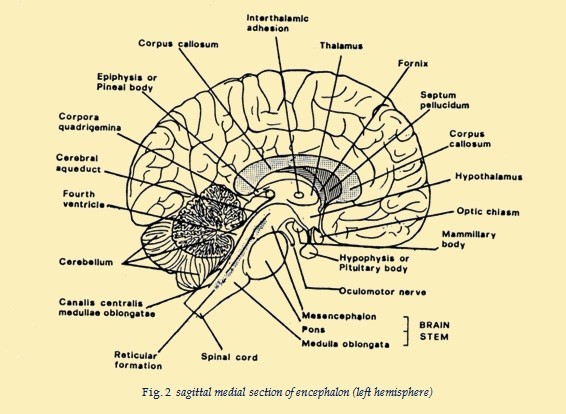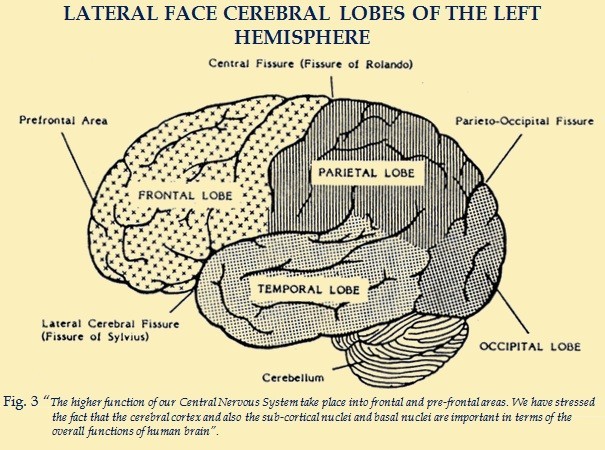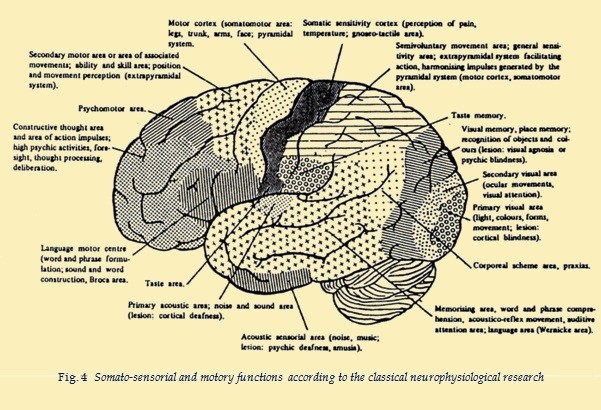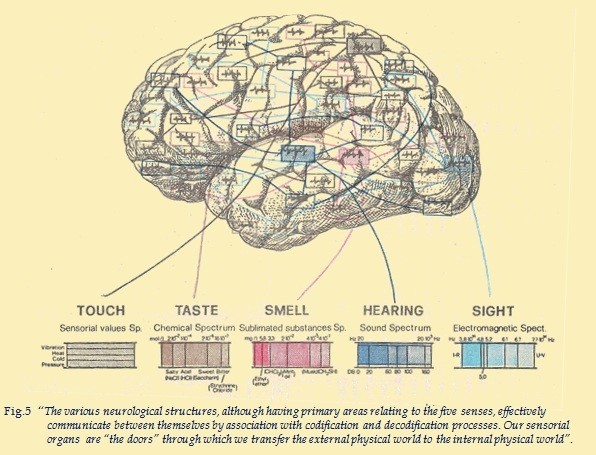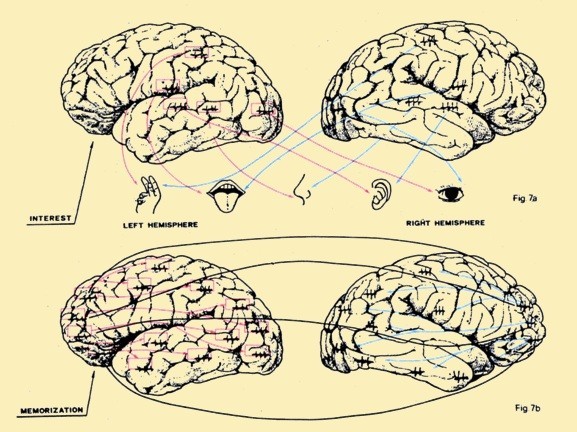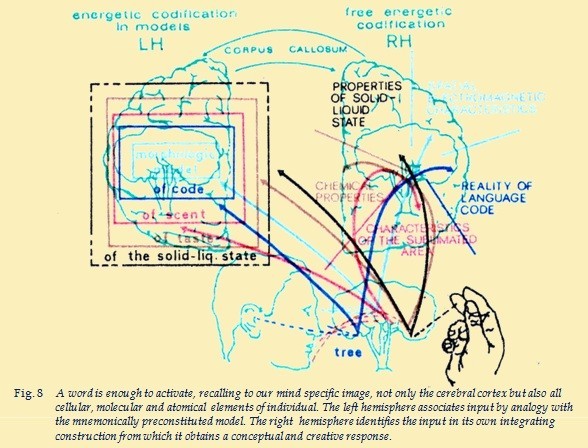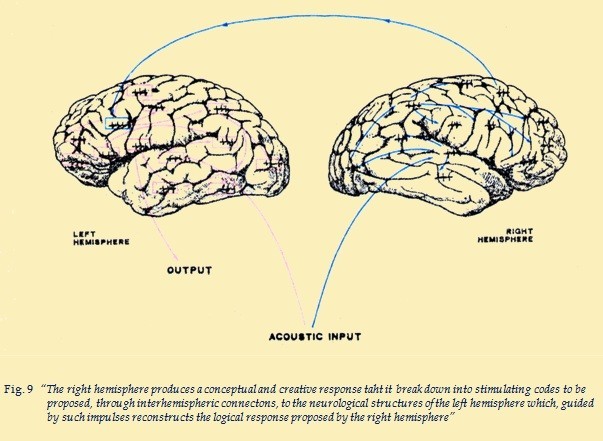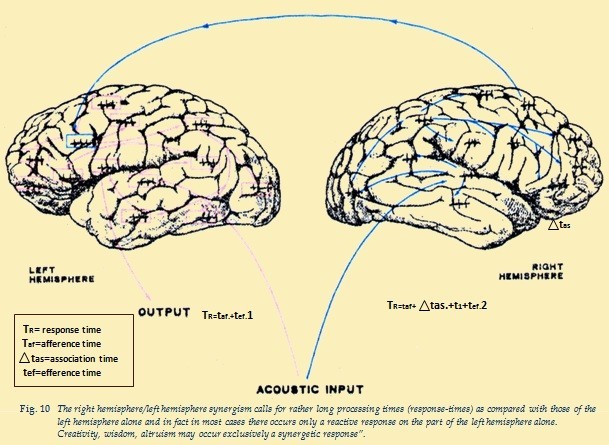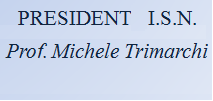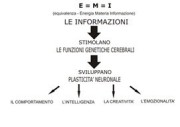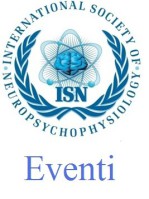THEORY ON THE
NEUROPSYCHOPHYSIOLOGY OF LEARNING
Michele Trimarchi
II RIUNION IBERO – AMERICANA SOBRE EDUCACION PARA EL DESARROLLO
Sisber 84, Madrid, November 12-16, 1984
INTERNATIONAL CONFERENCE OF THE
INTERNATIONAL ORGANIZATION OF PHYCHOPHYSIOLOGY (I.O.P.)
Praga, September 12-17, 1988
The human brain, this magnificent work of nature, with its cyto-architectonic, appears “technologically” imposing if compared with the amount of work and scientific knowledge that is required to produce a computer. The procurement of suitable materials for the instruction of minicomputers, as also the relative competence in specific fields required to achieve the cybernetic and electronic functions help us to understand the immensity of this work of nature which without our human intervention has achieved the dynamic (neuronic) minicomputers that generate “microcircuits” that are integrated between themselves and constitute the entire fact of human existence.
The overall functions of the human brain are activated by sensorial intakes that promote the individual’s intelligence and creativity; these two aspects of the human individual therefore depend upon such intakes insofar as they determine the degree of intellectual and creative functioning. From this it may be deduced that the function determine the organ taking us its point of departure the physiology of the organ itself. Therefore, the attribution of potentials in terms of superiority or inferiority to the individual’s intellectual capacities without understanding of the fact that it is the social environment that determines human ethology through education.
In every child born in any part of our planet there is this magnificent “technological” work of nature ready to bring into existence a human being that, in terms of intelligence, creativity and wisdom, is potentially qualified to exceed the present boundaries of human knowledge.
The subdivision into areas developed by Brodmann (fig. 1) on the cerebral cortex should not lead us to think, as sometimes happens, that there exists an effective demarcation line between such subdivisions that separates visual perception from auditory perception of from sensitive or motory perception, but rather we must, that there are areas primarily involved in what is specifically said about them that, without a demarcation boundary, codify, decodify, integrate and transform images into sounds or words , olfactory perception into words and images, words into images, etc.
This astonishing process, guided and directed by the sensorial intakes, must be understood in full detail if there is to be achieved a pedagogy that facilitates the development of the higher integrative functions which can process information through the coordination of logical and analytical codes without undergoing those inhibitions that psychologically hamper the “liberty” of creative expression on the part of the human being.
If this does not occur it cannot be said that the individual is “idiot”, autistic, etc; rather, we must only think that such functions have not been adequately stimulated and therefore educated by means of correct procedures.
Agnosias, dyslexias, apraxias, etc. therefore, where no specific damage is visible or identifiable, must be considered in different scientific terms – that is to say – it is necessary to ascertain to what extent the family and social environment has activated such conditions, and thus it is necessary to avoid attributing these to not-existent pseudo-syndromic psychogenetic pathological conditions.
Having stressed the fact that all cerebral cortex and also the subcortical nuclei and basal nuclei (fig. 2) are important in terms of the overall functions, let us devote our attention to the frontal and prefrontal areas (fig. 3) that may be defined as the zones in which the processes of integration of human experience occur.
The interneuronic communication routes are immense and each zone or area of the cortex communicates bioelectrically with all the other areas and with the soma. The various types of somatic receptors inform the cortex as to the entire organic and functional situation which in turn is enabled to send informational messages that are employed in preserving the homeostasis as a whole.
Conventional literature on neurophysiology very clearly defines the somatic-sensorial and motory functions (fig. 4); what has never been clearly stated is how thought forms in the human brain and how such thought interacts with the environment. Thanks to more recent studies in the field of neuropsychology it is today possible to follow a sensorial input so as to understand which areas are affected. Acoustic, visual, olfactory signals and those given by taste or touch – although transmitted by their respectively channels – are capable of activating the entire cerebral cortex through associative and mnemonic-integrating processes. (fig. 5)
This primarily depends on “experiences” and on the synaptic bonds that such experiences have succeeded in creating between the various neurological structures that, although having primary areas relating to the five senses, effectively communicate between themselves by association with codification and decodification processes in consequential constructions that in their relationship form ideas and thoughts, causing the individual to progress towards his personal cultural evolution that identifies itself in his specific personality.
This consequential order of the logical constructions is set in motion by the information intakes. Each time an item of information does not find its appropriate place in preceding mnemonic construction it is immediately blocked by the central nervous system’s defensive apparatus that develops an attack against the source from which such item of information comes.
This biological process that gradually develops after the initial years of the individual’s existence is commonly termed “aggressiveness” or “reaction to informational inputs”.
In effect, our mnemonic inputs take the ascendency over us until we have learned to utilized the input data for a purpose that is truly personal developing the capacity (for the will) to integrate all items of information since each item would find its place in our cerebral structures. What is in opposition to all this is in fact the ascendency over us that derives from items of information that already form part of our neurological structures. It is for this reason that, today, education must profoundly understand this process in order to achieve open information, newly “available”, that does not enslave the individual from the moment of birth.
The sensorial input process and the extent to which this stimulates the cortex will depend upon the total of precedent memorizing. In the case of an individual who has stored up a great deal of culture and numerous experiences will bring about a less ractional and more instinctive response that from the functional standpoint will be more intensive both in the positive and the negative sense.
In its physiological construction the brain is equipped with biological mechanisms designed for the preservation of cerebral homeostasis. These develop in potency and intensity of action in step with the biological ontogenetic development and are regulated by blocks of data that are gradually modified so as to adjust and regulate the action of such mechanisms. In neurophysiological terms it may be said that they govern the processes of activation and synaptic inhibition and, in consequence, guide the course of sensorial inputs and also memorizations and the relative response to the inputs themselves. In overall terms this process brings about that world that we define as “ethological-human”; psychology has counted upon understanding such processes on the basis of constant experimentation, making use of ever more sophisticated stimulatives instruments.
These instruments set in motion processes of interaction between the instrument and the human brain for the purpose of developing theories that can explain man’s “normal” behaviour. This type of experimental methodology, although useful and realistic, continues to be partial since in fact the resulting latencies vary from individual to individual according to neurophysiological condition that obtains. In consideration of all this, we must today aim at developing a basal theory that explains the physiological working of cerebral dynamic functions and subsequently the comparative study of these with the dynamics of sensorial memorizing. This will lead to a new psychology able to integrate all neurophysiological research and thus reorganize culture by adapting it to man’s creative development.
The outcome of our study shows that all the experiences achieved and the research conducted by the neurosciences are positive and, if integrated one with the other, will provide an overall vision of the human brain’s neurophysiological functions.
We are by now able to understand that, in order to memorize new inputs, the brain must be motivated: motivation permits and directs the action that tends to enable input to penetrate and brings about the processes of the constructive educational progress of the ego in the human individual.
It is precisely on the point that we must dwell inn order to pinpoint the effective motivations that induce societies to repeat educational methodologies that do not permit the development of a creativity capable of overcoming the present state of social deterioration.
What distinguishes us from the animal world is the higher functions of our central nervous system: such functions develop in the frontal and prefrontal areas. Ideas and creativity are a human prerogative and can occur in particular neuropsychological situations. The conditions necessary for the creative development of the individual are:
a) Educational information must never be presented as an order to be executed or repeated;
b) Each item of information must be identifiable with real, objective situations of the environment in which the individual lives;
c) The gradual development of the individual’s mnemonic construction is physiologically consolidated through items of information that are in all cases to be associated with preceding mnemonic inputs;
d) The sensorial organs of perception must be gradually educated to the integrated use of the physical possibilities of their analysis spectrum;
e) To avoid psychological gaps in the construction of creative personality it is necessary to achieve continual training that promotes conceptual synthesis and that stimulates ideas and creativity trough the global utilization of mnemonic inputs which must be objective in their specific significance;
f) The psychological control of the integrating development of the perception of input deriving from the five senses; such control will make it possible to verify the effective activation of the frontal cytoarchitectonic;
g) Psychological control of the contemporaneous activation of the frontal areas of the two cerebral hemispheres.
Point a) highlights the fact that information to be stored in the memory must always create the possibility of “non – violence” in respect of the brain/information interaction. The purpose of this is to prevent the brain from subsequently employing the violence that it itself has endured since this world increase the potency of the biological mechanism of aggressiveness – which is clearly observable today in human beings in view of the “errors” that are being committed in family and social education. The “proposal” may be accepted in ideal conditions, (fig. 6, 7) that is to say: observation → interest → mnemonic input (fig. 6b) → interest renewed insofar as this proves useful for the enrichment of preceding mnemonic inputs (fig. 7a) → mnemonic inputs and integration with the consequent growth in terms of the individual (fig. 7b).
The associated and integrating elaboration that permit the above outlined process frequently occurs without our being aware of it and only the sensation that derives from it is perceived. It will be the task of the Educator to render the student as aware as possible of the motivations and utility of the proposed items of information.
Point b) establishes the fact that the gradual gnoseological development of the child it is not possible to preclude the objectivity of inputs relative to the morphological and semantic identification of the environment into which the child is born. This process must be guided during the initial phase by the parents and care must be taken to avoid the possibility that inputs that cannot be associated between themselves and that come from the mass-media may adulterate the purity and harmony of the development under way.
If until today it “was possible” to neglect the child/environment relationship, in the present context this is no longer possible owing to the fact that the social and family environments are in a chaotic condition and present a considerable volume of information that is in no way connected with education and that does not take into account the damage that derives from such information. It is in fact today evident that children who live in industrialized and supercivilized environments feel themselves to be “grown up” at 12/13 years of age and develop in a way that is in conflict with social life and their own existence. The responsibility for this is to be traced to the chaotic information that creates an effective condition of entropy of information that, in consequence, has dynamic repercussions upon the brains of the individuals in question.
Point c) primarily relates to education. In consideration of the fact that there exists today both in family life and in society a gradual disintegration of educational (moral, ethical, social) rules, we must necessarily go on to the development of an awareness that can effectively physiologically and scientifically achieve a gradual creative, educational development.
To avoid becoming too abstract we would propose integration between:
- The primary requirements relative to the economic situation;
- The secondary requirements that reflect the social and cultural development situation of which the former is part;
- The human requirement inherent in the natural rights of man (justice, morality, religion, liberty, ect.).
Present-day social organizations have shared out the tasks of coordinating development by operating principally in the world of labour or in the field of economics but they have neglected to undertake objective action in the field of human rights. In fact, in the various nations there does not exist a Ministry of Human Rights whereas we believe that a Government Department of this kind should not only exist but should guarantee the objective functioning of man’s natural rights al all levels of social development.
This would make it possible to develop a universal social being who while facing the problems inherent in local needs, would have a cultural base without those limitations that trigger in the various brains the defense of the their own memorized models – almost always in conflict one with another – thus restricting the possibility of interaction between the world’s populations.
Emphasis is to be laid upon the physiological difference existing between man and woman who are both compelled to develop a gnoseological construction that closely conforms to their natural and social roles and that does not permit above all the overcoming of the alibi constituted by the prevarication of one above the other.
The gradualness of the gnoseological construction in the case of each individual must be achieved through an epicentric mnemonic construction that places the individual ego at the centre of its own being. Such ego must always hold together and efficiently direct all mnemonic development.
Points d) and e): in consideration of the fact that our sensorial “instruments” are of fundamental importance in man’s gnoseological construction, we must dwell upon their physiology, capacity of physical analysis spectrum and the interacting relationship between them and the cerebral neurological functions.
Our sense organs are the “doors” through which we transfer the external physical world to the internal physical world. Through them, under the form of luminous messages, mechanic-pressure vibrational messages, chemical interactions, we identify the environment and ourselves.
The visual spectrum of solar electromagnetic emission enables our visual perception organs to receive the responses that all the elements interacting with the light around us give to the light itself. It may be said that we are able to be observes of the “dialogue” that takes place between light and the environment. If we were aware of the importance of this process, we could consciously take part in the harmonious interactions of nature in the same way in which our auditory organs enable us to listen to a recording of classical music.
To achieve this, it is necessary to understand the language that energy employs: normally, we perceive sensations into language or logic means to be able to transmit in comprehensible codes the life experiences that are peculiar to others, and this would improve social and human relations with the consequential improvement of the quality of life itself. This natural process of learning and expression that has until now been the prerogative of poets, scholars, thinkers, etc. can today become an educational methodology for all human beings.
Regrettably, our sensorial organs are not free to use the entire spectrum of perception since they are conditioned by cerebral mnemonic intakes. Images, forms, sounds, etc. that have been stored in the memory condition future sensorial perception. In effect, we are seeking in the environment all that we identify with our purposes and gnoseological models. The verification of this neurological mechanism is very simple and does not call for any special laboratory instruments; it will suffice to look around us with the intention of perceiving what normally escapes our attention. It will thus be easy to discover that a considerable part of the objective reality that surrounds us had not been perceived because of the discriminating neurological mechanism set up by education or by the limits imposed by preceding mnemonic inputs. In effect, the human brain is really interested in “everything” since “everything” would find its proper place in the individual’s neurological structures through the dynamic enrichment of the individual himself.
To render our neurological structures and sense organs functional it would be necessary to be endowed with a culture and education that facilitate the process describe above. This would show us how the brain of the “genius” exists in all human beings from the time of birth and is limited only by family and social education. With the technological means that society has at present at its disposable – if there were properly employed – it would not be difficult to offer man the possibility of discovering himself and the world in which he lives.
Through their studies genetists are today discovering the mnemonic capacity of a cell. This infinitesimal organism operates in the environment through employing all its potentials so as to make its contribution to life. One can easily make analogies with the principles that govern the biological world on the basis of which there exists at the moment of an organism’s birth a dynamic philogenetic memory that will permit the organism itself to experiment, over the span of its existence, a new way of interpreting the environment. In man, too, there exists this same potential and it is represented by all the cellular structures functionally linked between themselves that avail of a hierarchic philogenetic memory ready to set up a relationship with the surrounding environment. It is a known fact that the neurological cells of the nervous system of the individual do not reproduce themselves and this shows that the genetic memories of such cells contain all the possible biochemical combinations that can occur over the span of human life in interaction with the physical world. When one thinks that we construct the ego, the personality, taking as our point of departure the philogenetic mnemonic reality of the central nervous system’s cells, we can today discover the neurophysiological keys to learning that achieve the ontogenesis of the ego and of the personality itself.
All this helps us to understand the dynamism of our existence, of our daily moments whether these be psychological or somatic and that, in fact, even if they are not always understood, represent the true innovations of our cellular memories.
It may be affirmed therefore that each item of information, whether psychosensorial or received in the form of proteins, vitamins, etc. creates an objective modification.
For greater clarity, we would stress the fact that we consider “items of information” – however diversified – as being constituted also by vitamins, proteins, etc. that is to say, our global interaction with the environment.
Furthermore, it may be affirmed that the dynamism of overall interactions must, scientifically speaking, be understood if we seek to avoid the macroscopic errors that we have inherited from our history.
Interaction between the various sense organs takes place effectively in our nervous system. At the moment when a word recalls to our mind a specific image there occurs, neurologically, an entire series of interneuronic interactions which have set up an “association” in psychological terms.
The image thus retrieved may in turn evoke an entire series of images that can subsequently give rise to thoughts, ideas, sensations, etc. We note therefore that a single word can in effect activate not only the cerebral cortex but also all the cellular, molecular and atomic elements that constitute the individual. Each image, each word, each idea, creates from time to time a series of sensations and emotions that, under the form of internal stimuli, attain both the peripheric zones of the nervous system and the entire soma and continue to create great difficulties for the advancement of knowledge.
Such difficulties have by now become evident to numerous scientists and this has brought about “orientations” towards multidisciplinary forms that are of advantage in achieving the integration of the sciences.
We cannot therefore subtract the soma from the psyche, biochemistry form psychological activities, since these are translated into biochemistry but biochemistry is merely the substratum on which the psychological functions are constructed. Together with pharmacological studies, the field of biochemistry attempts to condition behavior, hence psychology: we hold that this course is highly dangerous insofar as it is included in a psychological process, modifying and altering it, and in consequence damaging the dynamic achievement of personality. There should not exist any “pill” that modifies human behavior , and we know that such behavior is the result of the processing of social and environmental data. To act upon human behavior , therefore, what is needed is a physiological therapy that permits the “healing” of behavior that is to be considered “abnormal”.
It seems to us obvious that the scientist researching the biochemical alterations of behavior on the basis of pre-constituted parameters discovers in the organism in question a quantitative modification of the neurointermediaries, of the neurohormones, etc. and, if the individual examined is submitted to psychological tests aiming at the modification of his behavior, the biochemistry of the cerebral structures will consequently be altered in course of time.
This occurs since the quantity of synthesis of the molecular elements on the part of neurological cells designed for psychosensorial activities depends upon the extent to which these cells are stimulated by inputs (that is to say, by the extent to which they are made to work). This process takes place also in the neurological circuits designed for psychomotory activities; in the course of time, if the relationship between sensitivity, motivity and gnoseological construction does not maintain an interacting dynamism, a slowdown in biochemical and bioelectrical activities will take place on the individual with consequent atrophies and pathological conditions.
Sports, dancing, ballet, etc. that it to say, a co-ordinated motory activity involving all the functions inherent in the pyramidal and extra-pyramidal system together with an appropriate nutrition, maintain somaticomotory equilibrium that enables our higher psychological functions to utilize a body that rapidly responds to all creative and psychological requirements.
It is not possible therefore to omit from the education/learning process methodologies that aim at the individual’s strong, healthy and energetic growth. Moreover, gnoseological creative attainment must always take into account health and development, as also the possibility of the employment of one’s own body. In consequence, man must be prepared from birth for an allover development that can build up a consciousness able to respond to all the needs he will have to satisfy.
We believe however that all laboratory analyses and biochemical studies on behavior are of great advantage in assisting us to behavioral process; this applies also to those biochemical processes that relate to specific sensorial stimuli.
Our theory on Lateralization of the Cerebral Hemispheres, published in the first issue of this periodical, permits us to develop a new psychology on the basis of objective tests for the verification of the gnoseological processes and creative capacities of the individual. Such tests cannot omit the basic theory and must be psychological, therefore they are conducted on visual, auditory, olfactory, etc. observations, with the relative gnoseological constructions and consequent response times. On the basis of this theory it is possible to ascertain to what extent the various cortico-cortical and interhemispheric functions are activated, which types of observation and relative codification and decodification occur from the verbal or written description of an image and whether such descriptions are conceptual, repetitive or creative. These tests cannot therefore demonstrate an intelligence that is an end to itself (computer type) but rather the overall dynamic psychological development of the individual. It will thus be possible to act by allocating specific tasks for the development of psychological (therapeutic) activities so as to compensate those cerebral potentials that are not “normally” activated in life and in the environment by the individual himself and that over a period of time create “psychogenic syndromes” in the true sense.
Points f) and g): the imposing number of sensorial intakes deriving from the mass-media brings about a quantitative increase in memory inputs and in processing as also associations in the central nervous system. This permits the rapid development in children of forms of thought that frequently condition the child’s cultural ontogenesis and biological development in a negative manner. The lack of specific knowledge in regard to information and how the brain elaborates and integrates such information gives rise, especially in young people, to autistic forms that impel the individual to drug addiction, neuropsychiatric treatment, psychotherapies, etc. In many cases there occurs a condition of hormonal imbalance with consequent somatic damage that limits the physiological development of the child.
One frequently observes forms of marked intelligence in young people that subsequently cause them to be attracted by drugs, criminality, etc.
These forms of intelligence are not always positive elements since they consolidate in the brain without an objective guide aiming at the overall development of the individual in question. Particular family and social environments supply such data for their own purposes in contrast with the intrinsic purposes of the individual who receives them.
We would call attention on a matter of extreme importance – this is the fact that what we admire in a computer in terms of its capacity to process data at high speed is in fact a function of the human brain. We should not therefore feel surprised when we find a child who is able to process information (a capacity that is commonly defined as “intelligence”), but rather we should work on this process so that the intelligence itself is translated into creativity that can prove of advantage to the individual’s overall growth without those discriminating elements that condition the interactive relationship with the environment and , in fact, strengthen the mechanism of aggressiveness against all that is discriminated.
If the construction of the individual’s ego were considered an educational project to be implemented, we would be able to apply from birth an informational teaching system free of error since it would be based upon our research and checking of the goals to be attained.
We note instead that informative segments are offered to meet the requirements of these constructions without following appropriate and gradual development processes. In fact, such segments form part of a chaotic world that in its condition of imbalance and with specific and highly potent “electromagnets” seeks to attract to itself individuals by conditioning them to the most inappropriate interactions thus preventing human and social self-fulfilment.
The human brain with its two hemispheres dynamically processes and integrates the sensorial intakes for the achievement of the conscious ego. The psychologically conscious ego forms primarily in the left hemisphere but this must not cause us to believe that such consciousness is our objective reality, since at one and the same time we have a form of process for the elaboration of data that we do not always succeed in materializing in a psychological awareness. Such elaboration occurs in our right hemisphere and stresses what we commonly call “higher sensitivity”.
We can today enjoy our individual existence if we permit an objective integration between the sensitive elaboration of the right hemisphere and consequent logical materialization in the left hemisphere. When the sensation is transformed into analytical logic there takes place a synergism that may be identified as “joy” or “suffering” of the “higher” type in respect of the process of Stimulus/Response interaction that creates momentary pleasure or anguish, anxiety and tension.
The neuropsychophysiology of learning may be summarized as follows:
- Sensorial input reaches specific areas of the two cerebral hemispheres (Fig. 8);
- The left hemisphere associates such input by analogy with the mnemonically preconstituted model and consequently formulates a response on the basis of the requests for information it receives;
- The right hemisphere identifies the input in its own integrating construction from which obtains a conceptual and creative response that ii breaks down into stimulating codes to be proposed, through interhemispheric connections, to the neurological structures of the left hemisphere which, guided by such impulses, reconstructs the logical response proposed by the right hemisphere and materializes this by means of verbalization or other typical forms of expression or in some other ways (Fig. 9)
The right hemisphere/left hemisphere synergism calls for rather long processing times as compared with those of the left hemisphere alone and in fact in most cases there occurs only a reactive response on the part of the left hemisphere alone. Creativity, wisdom, altruism may occur exclusively through a synergetic response.
Awareness of this process permits us to check at any given moment both our own interactions and those of others and, above all, it enables us to avoid the improper use of human and universal principles aiming at goals that are not compatible with those established by the principles themselves. Teaching, psychology and sociology must re-think their specific fields of study bearing in mind that these cerebral mechanisms exist if they wish to render a service to man and society.
In consideration of the fact that the most effective experimental test of this theory can be carried out on oneself by checking the interactive responses against one’s own social environment, it is possible, from time to time, to alter one’s mental condition by measuring he length of time required by one’s own responses and by seeking to facilitate the synergetic operation between the two cerebral hemispheres (Fig. 10)
In brief, it is necessary to impede the individual’s rapid reactions in the face of stimuli of various kinds by seeking in one’s own mind the more suitable response to the situation in question and recognizing the fact that the other person has the same cerebral mechanisms as oneself.
In the present world situation the speed at which information travels and the chaotic life of our cities partly hamper the interhemispheric synergism and consequently the creative nad conceptual expression of ideas. This obliges the right hemisphere during to undertake creative actions in respect of the left hemisphere during the periods in which this latter does not receive stimuli from the environment that is to say during the hours of sleep.
This process gives rise to dreams, that is to say, to all the oneiric activities that seek to create in the left hemisphere a neurological situation that is physiological in respect of the action of the right hemisphere.
It is possible for us today to face scientifically the problem relative to the unconscious in relation to the human brain’s redundant activities.
Considering the enormous processes of activation/inhibition that occur in the cerebral hemispheres in face on sensorial inputs, we note that in fact the responses to such inputs are purely relative in respect of the overall biochemical activity of the brain. In going more deeply into these subjects, we have been able to ascertain that quite different responses to the initial input are given by the same individual with other mnemonic constructions at moments and in periods and circumstances that are totally different. This shows us how the activities of our two hemispheres engage in a “self-conscious” task, “reserving the right” to make us participate psychologically at the moment when stimulating situations that evoke the initial input occur.
The redundant activities of our neurological structures bring about a psychologically unconscious “consciousness” showing us that the goals established for our brain go well beyond the life that we live in our daily consciousness.
In all this in fact our right hemisphere plays its role since, finding itself at a disadvantage in terms of its responses as compared with the left hemisphere, the right hemisphere prepares over a period of time its own responses so as to transfer them creatively through specific stimulations in the left hemisphere’s zones designed to process and integrate them through its own functional system. It is as if the left hemisphere received stimuli from the outside that permit a neurological activity identical with that which takes place during the conduct of daily life. The right hemisphere therefore in its higher cerebral functions develops a creative, dynamic, sagacious individual who by nature does not impose himself or command but always creatively proposes responses that he supplies at the moment when the interacting situation permits him to do so.
In effect, during REM sleep, the entire electrocortical activity reveals an oneiric activity that brings about numerous different situations as if these were situations appertaining to everyday life. This gives us to understand that our intuitions, our sudden ideas and above all our dreams have a precise purpose that tends to build up a “consciousness” that switches from the subjective to the objective so as to enable us to modify that “character” that we achieve in the left hemisphere and which is not always in harmony with the wisdom of our right hemisphere.
In neurological terms it may be said that the right hemisphere carries on a process of elaboration and integration of information and consequently sends stimulative codified impulses through the interhemispheric fibres so as to reconstruct its creative elaboration in logical terms.
Experiments on the stimulation of lateralization carried out on individuals who underwent commissurotomy (resectioning of the corpus callosum) have shown that an intervention of this kind does not bring about substantial changes in the individual’s personality.
This shown us how little we have understood, scientifically speaking, on the activities of our right hemisphere since in fact education and social development impose repetitive cultural models that are consolidated in the left hemisphere and condition a form of life and society that does not promote creative development and does not permit the integration if interactive divergences since these cultural models refute innovations that are not associated with preconstituted models. This urges our right hemisphere to undertake creative activity that by nature does not include the analytical logic of the model as an aim in itself. In effect, the more the right hemisphere operates on the left hemisphere in social interactions, the more the individual is rejected by preconstituted models and then, historically, we discover that the individual in question had anticipated future evolution since in the course of time models become saturated and necessarly undergo transformations, employing for their new reconstitution what years earlier had been refuted.
It may also be observed that if our right hemisphere were properly used we would spare ourselves a great deal of suffering and hardship from the social and human standpoints.
Moreover it seems to us “antiscientific” to think that nature – having shown her capacity to create the wonders that surround us – has committed the very grave “error” of furnishing us with half of our brain “handicapped” in respect of the other, presumably dominant, hemisphere.
The story of David and Goliath is one of the many instances that gives food for thought on the macroscopic nature of the errors that may be committed by underestimating what, for the moment, cannot be comprehended.
At this point we believe everyone has clearly understood the sources of our intuitions, certain of our sensations and those sudden, felicitous ideas engendered in our mind, just in same way as many solutions to scientific, social and human problems are supplied through oneiric activities.
By nature, the creativity of the right hemisphere is always innovative whereas the functioning of the left hemisphere is repetitive; however, the left hemisphere too is capable of developing a rudimentary form of creativity or innovation by combining various mnemonic puzzles in a haphazard way and putting together different segments of preconstituted cultural and morphological models. It is fact true that this type of “creativity” predominates in the history of cultural, artisan and technological activities.
Our difficult task is to verify history on the basis of these studies so that progress may be made through utilizing the contributions given by all mankind and in this way to become today conscious of and responsible for a tomorrow in which Man can discover the aim of his existence.


